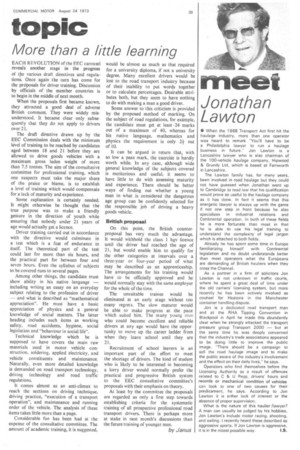t o p i c
Page 41

If you've noticed an error in this article please click here to report it so we can fix it.
More than a little learning
EACH REVOLUTION of the EEC carousel reveals another stage in the progress of the various draft directives and regulations. Once again the turn has come for the proposals for driver training. Discussion by officials of the member countries is to begin in the middle of next month.
When the proposals first became known, they attracted a good deal of adverse British comment. They were widely misunderstood. It became clear only subsequently that they do not apply to drivers over 21.
The draft directive drawn up by the EEC Commission deals with the minimum level of training to be reached by candidates aged between 18 and 21 before they are allowed to drive goods vehicles with a maximum gross laden weight of more than 7.5 tonnes. The aim of the consultative corhmittee for professional training, which one suspects must take the major share of the praise or blame, is to establish a level of training which would compensate for a lack of maturity and experience.
Some explanation is certainly needed. It alight otherwise be thought that the true purpose was to make a friendly gesture in the direction of youth while ensuring that nobody under 21 years of age would actually get a licence.
Driver training carried out in accordance with the directive would culminate in a test which is a feat of endurance in itself. The theoretical part of the teat could last for more than six hours, and the practical part for between four and seven hours. Even the syllabus of subjects to be covered runs to several pages.
Among other things, the candidate must show ability in his native language — including writing an essay on an everyday subject relating to the profession of driver — and what is described as "mathematical appreciation". He must have a basic appreciation of physics and a general knowledge of social matters. The latter heading includes such items as working safety, road accidents, hygiene, social legislation and "behaviour in social life".
Technical knowledge which he is supposed to have covers the main raw materials used in motor vehicle construction, soldering, applied electricity, and vehicle constituents and maintenance. Naturally, even more detailed knowledge is demanded on road transport technology, driving technology and road traffic regulations.
It comes almost as an anti-climax to reach the sections on driving technique, driving practice, "execution of a transport operation", and maintenance and running order of the vehicle. The analysis of these items takes little more than a page.
Considerable fun has been had at the expense of the consultative comniittee. The amount of academic training, it is suggested, would be almost as much as that required for a university diploma, if not a university degree. Many excellent drivers would be lost to the road transport industry because of their inability to put words together or to calculate percentages. Desirable attributes both, but they seem to have nothing to do with making a man a good driver.
Some answer to this criticism is .provided by the proposed method of marking. On the subject of road regulations, for example, the candidate must get at least •24 marks out of a maximum of 40, whereas for his native language, mathematics and physics the requirement is only 2+ out of 10.
It can be argued in return that with so low a pass mark, the exercise is hardly worth while: In any case, although wide general knowledge of the subjects covered is meritorious and useful, it seems to have little to do with assessing maturity and experience. There should be better ways of finding out whether a young man in what is considered the dangerous age group can be confidently selected for the responsible job of driving a heavy goods vehicle.
British proposal
On this point, the British counterproposal has very much the advantage. It would withhold the class 1 hgv licence until the driver had reached the age of 21, but would enable him to qualify for . the . other• categories at intervals over a three-year or four-year period of what may be described as an apprenticeship. The arrangements for his training would have to be officially approved and he would normally stay with the same employer for the whole of the time.
The unsuitable trainee would be eliminated at an early stage without too many regrets. The slow maturer would be able to make progress at the pace which suited him. The many young men who could become excellent and reliable drivers at any age would have the opportunity to move up the career ladder from when they leave school until they are 21.
Recruitment of school leavers is an important part of . the effort to meet the shortage of drivers. The kind of student who is likely to be interested in becoming a lorry driver would normally prefer the practical and progressive British system to the EEC consultative committee's proposals with their emphasis on theory..
At least by the committee the proposala are regarded as only a first step towards establishing criteria for the systematic training of all prospective professional road transport drivers. There is perhaps more at stake in next month's discussions than the future training of younger men.
by Janus




















































































